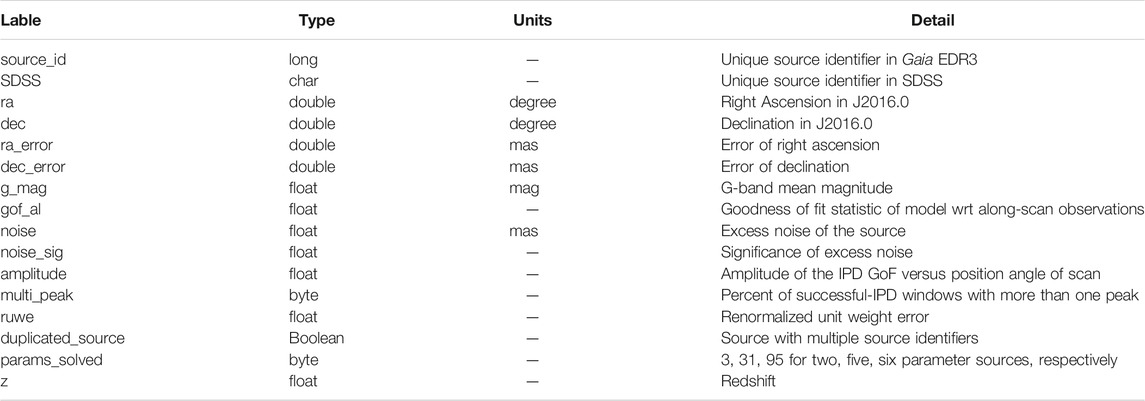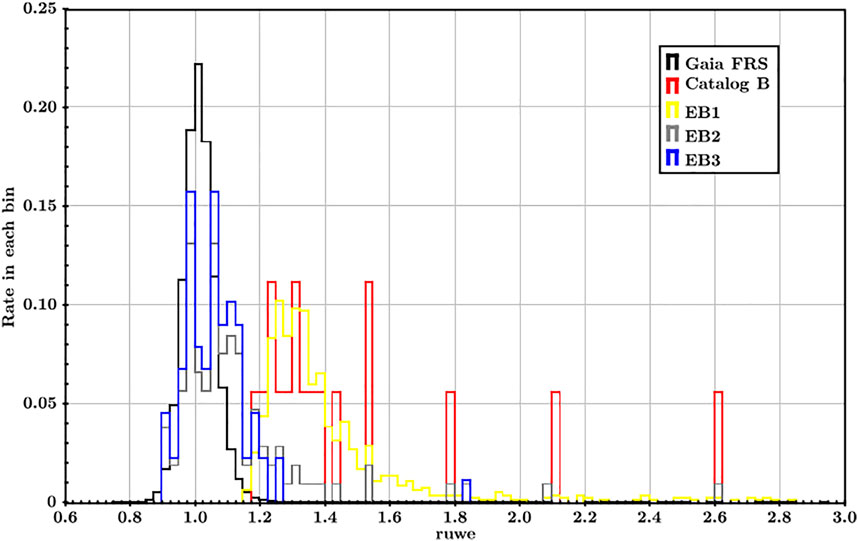- 1Shanghai Astronomical Observatory, Chinese Academy of Sciences, Shanghai, China
- 2School of Astronomy and Space Sciences, University of Chinese Academy of Sciences, Beijing, China
Given their extremely large distances and small apparent sizes, quasars are generally considered as objects with near-zero parallax and proper motion. However, some special quasars may have abnormal astrometric characteristics, such as quasar pairs, lensed quasars, AGNs with bright parsec-scale optical jets, which are scientifically interesting objects, such as binary black holes. These quasars may come with astrometric jitter detectable with Gaia data, or significant changes in the position at different wavelengths. In this work, we aim to find these quasar candidates from Gaia EDR3 astrometric data combining with Sloan Digital Sky Survey (SDSS) spectroscopic data to provide a candidate catalog to the science community. We propose a series of criteria for selecting abnormal quasars based on Gaia astrometric data. We obtain two catalogs containing 155 sources and 44 sources, respectively. They are potential candidates of quasar pairs.
1 Introduction
Since the discovery of the first quasar in 1963 (Schmidt, 1963), this type of extremely distant active galactic nuclei (AGN) has gradually become the focus of astronomical research. In astrometry, a large number of evenly distributed quasars can be used to establish a celestial reference frame (Ma, 1997; Ma et al., 2009; Mignard et al., 2018; Charlot et al., 2020) because they have almost zero proper motions and point-like shapes. On the other hand, quasars are also a critical pathway to explore the evolution and mergers of galaxies in astrophysics (Begelman et al., 1980; Shen et al., 2021).
There are many surveys concerning the identification of quasars such as the large Bright Quasar Survey (Hewett et al., 1995), the 2DF Quasar Redshift Survey (2QZ, Croom et al., 2004), the quasars from Large Sky Area Multi-Object Fiber Spectroscopic Telescope (LAMOST, Luo et al., 2012) and Solan Digital Sky Survey (SDSS, Pâris et al., 2018; Lyke et al., 2020). A large number of quasars have also been identified through astrometry and mid-infrared methods (see, e.g., Secrest et al., 2015; Guo et al., 2018). The total number of identified quasars has exceeded one million, and these quasars have been collected and compiled into various catalogs (see, e.g., Véron-Cetty and Véron 2010; Souchay et al., 2019; Liao et al., 2019; Flesch 2021). Among these confirmed quasars, some spectroscopically identified quasars show abnormal astrometric characteristics in the Gaia high-precision astrometric observation (Wu et al., 2021). These abnormal quasars have large proper motions or significant astrometric noises, which means that they are not suitable to be used to establish the celestial reference frame. Shen et al. (2019) emphasize that quasars with significant astrometric noises may be dual quasars. These dual quasars are precursors of the binary supermassive black holes, which play an important role in the study of galaxy evolution and gravitational waves (GWs). At present, most of the known dual AGN are at low redshifts or have large physical separation (
Gaia is an astrometric satellite launched by the European Space Agency (ESA) on 19 December 2013 (Prusti et al., 2016). At present, Gaia has provided high-precision astrometric data for more than 1.8 billion sources in the G magnitude range from 3 to 21 mag (Lindegren et al., 2021). With the accurate position data and a large number of identified quasars, Gaia has been committed to establishing its own optical non-rotating celestial reference frame (CRF) (Mignard et al., 2018). Lindegren et al. (2018) selected 556,869 quasars from the third International Celestial Sphere Reference Frame (ICRF3) and AllWISE AGN catalog (Secrest et al., 2015) to establish the Gaia-CRF2 (see also Mignard et al., 2018). In Gaia Early Data release 3 (EDR3), the AGN catalog, which contains 1,614,173 sources, is obtained by cross-matching with 17 external AGN catalogs. The systematic errors in EDR3 have been greatly improved compared with DR2. The astrometric properties of the EDR3 quasars show that no significant residuals are found globally (Liao et al., 2021a,b), which provides us with a unique opportunity to select abnormal quasars in EDR3.
In EDR3, there are 585 million 5-parameter1 and 882 million 6-parameter sources with the measurement of parallax and proper motion, while the remaining 344 million 2-parameter sources have only positional data. The quasars used by Gaia were obtained by a cross-match of the full Gaia catalog with the external QSO/AGN catalogs, the matched sources were further selected to have parallaxes and proper motions compatible with zero within five times the respective uncertainty (Lindegren et al., 2018; Klioner et al., 2021). Therefore, among the common sources of Gaia EDR3 and the 14th data release of SDSS Quasars (SDSS DR14Q, Pâris et al., 2018), 308,601 of 367,516 quasars are contained in the Gaia EDR3 AGN catalog. For the remaining 58,915 quasars, 206 sources are ruled out due to excessive proper motion or parallax, and 58,707 quasars are excluded just because they do not have the measurement of proper motion and parallax. To make full use of the position information of these 2-parameter quasars, we need to judge the reliability of their astronomical information through other criteria.
In this paper, we try to explore the selection of quasars with abnormal astrometric characteristics using different combinations of appropriate astrometric parameters in addition to parallaxes and proper motions. In this way, we can not only evaluate the 5-parameter or 6-parameter sources more comprehensively but also appropriately select the 2-parameter sources to further expand the sample of quasars we can use in Gaia. Note that we are not selecting quasars with good observation parameters. On the contrary, we want to mark the quasars with poor astrometric parameters, which will provide some candidates for studying galaxy evolution and binary black holes.
This paper is organized as follows. In Section 2, we introduce the data and criteria for selecting quasars with abnormal astrometric characteristics. We show the results and evaluate these quasars in Section 3. In Section 4, we make some discussions about the extension of the catalogs and the identification of quasar pairs, and the conclusions are given in Section 5.
2 Data and Selection
2.1 Data Used
As addressed in the previous section, the AGN catalog in Gaia EDR3 (GEAC hereafter) is obtained by cross-matching with 17 external AGN catalogs. GEAC contains 1,215,942 5-parameter sources and 398,231 6-parameter sources. Besides, to calculate the rotation of the Gaia reference frame, the Gaia team selected 429,249 5-parameter solution quasars as frame rotator sources (FRS hereafter, Brown et al., 2021). Therefore, FRS is currently the most reliable quasar catalog in Gaia, and will be used as a comparison sample to evaluate the astrometric parameters of other quasar candidates.
As mentioned in the previous section, there have been many compiled quasar catalogs. The spectra classified quasars from SDSS contributed a large proportion. Considering the reliability and the indispensable images and spectra data of SDSS, we decided to use the SDSS quasar catalog as our input catalog to select the abnormal quasars. SDSS Data release 16 (DR16, Jönsson et al., 2020) is the latest data product from Apache Point Observatory Galactic Evolution Experiment (APOGEE)-2/Sloan Digital Sky Survey-IV (Blanton et al., 2017). And the quasar catalog of SDSS DR16 (Lyke et al., 2020) contains two catalogs: the quasar-only catalog and the “superset” objects targeted as quasars. The “superset” of all SDSS-IV objects targeted as quasars containing 1,440,615 sources and the quasar-only catalog containing 750,414 quasars. Due to the high completeness (99.8%) and low contamination (0.3–1.3%), we choose the quasar-only catalog as our initial sample of quasars (SDSS DR16Q hereafter).
2.2 The Selection Criteria
With a large number of quasars identified by SDSS spectrum, after cross-match with Gaia EDR3 in a 1″ radius, we obtain 489,402 common sources in Gaia EDR3 and SDSS DR16Q. Among them, there are 153 SDSS quasars with two Gaia matches, two SDSS quasars with three Gaia matches and one Gaia source with two SDSS quasars matches. We then exclude two SDSS quasars whose corresponding four Gaia matched sources are all with significant proper motion or parallax. These sources are compiled into the type A catalog of quasars with abnormal astrometric characteristics (Catalog A hereafter). These multiple-matched sources are potential quasar pairs or star-quasar pairs, which will be further discussed later in this paper.
For the remaining 489,285 quasars with only one Gaia source matched within a 1″ radius, to lower the possibility of star contamination in cross-matching, we exclude those sources with significant proper motion or parallax using the criteria mentioned in the previous section. Then we select several astrometric parameters emphasized in Lindegren et al. (2021) to evaluate their accuracy and reliability. These parameters can characterize the goodness of the point spread function (PSF) model fitting of each source and the reliability of the observation data. We will introduce them and describe in detail the criteria of our selection in the following parts.
astrometric_gof_al represents the Goodness-of-fit statistic of the astrometric solution for the source in the along-scan direction. The Gaia EDR3 documentation proposed a rough value of this criterion to distinguish between good and bad fitting of the data: if the astrometric_gof_al is greater than 3, it may indicate a bad fitting of the data. We have analyzed the reliability of this criterion by checking the statistical value of astrometric_gof_al from FRS sources. There are only about 3% of quasars in FRS that have the excessive astrometric_gof_al (
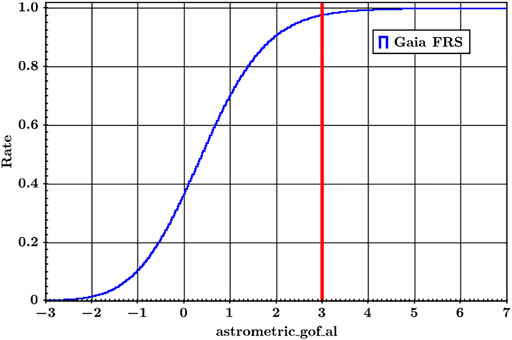
FIGURE 1. The cumulative distribution histogram for astrometric_gof_al values of sources in Gaia FRS. The red vertical line is astrometric_gof_al = 3.
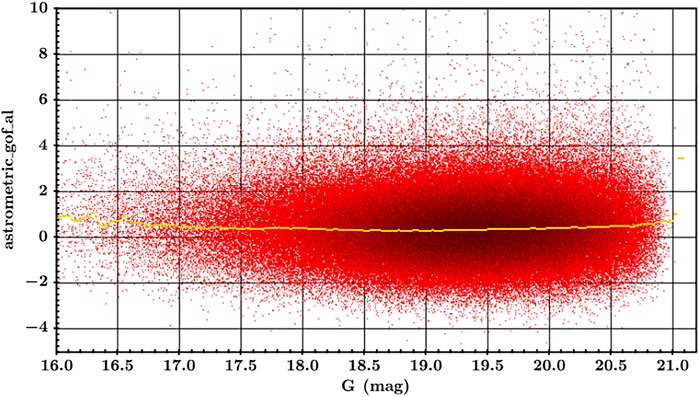
FIGURE 2. The distribution of astrometric_gof_al with the increase of Gmag. The red dots are data points, and the yellow line is the median line of each bin.
astrometric_excess_noise represents the disagreement between the Gaia observations of a source and the best-fitting standard astrometric model, and a large value signifies that the residuals are statistically larger than expected. There is no doubt that astrometric_excess_noise is an important indicator of whether the source is astrometrically “well-behaved”, but we need to make sensible cutoffs to ensure that the sources we selected are reliable and logical. With high accuracy and reliability, FRS is an ideal reference to determine the criterion of noise. As seen in Figure 3, with the magnitudes of the sources becoming fainter, the observation noises of the sources are also rapidly increasing. The 99.9% quantile line can retain most of the reliable quasars, and the blue points outside this line show obvious bias from the whole sample. Therefore, the red curve may be an empirically feasible criterion. We choose the 20.9 mag as the magnitude limit of this criterion since there are only 138 FRS sources fainter than this limit. We plot the quasars of SDSS DR16Q in the same figure and find 1982 of them meet this 99.9% quantile criterion2. Another parameter that could be used to evaluate the astrometric noise is astrometric_excess_noise_sig, which represents the significance of excess noise. Since the excess noise could absorb all kinds of modeling errors such as PSF (Point spread function) calibration errors and geometric instrument calibration errors (Lindegren et al., 2012), the astrometric_excess_noise_sig is important to evaluate if the noise is caused by the structure of the source. The Gaia document recommends that astrometric_excess_noise_sig > 2 indicates that the given noise is probably significant. We have not found any obvious correlation between the significance and magnitude in FRS, so astrometric_excess_noise_sig > 2 could be the sensible cutoff to ensure the excess noise is applicable for all magnitudes.
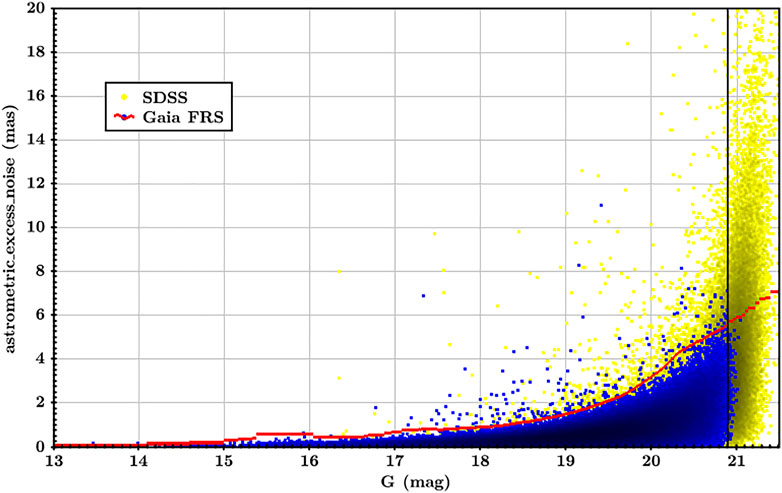
FIGURE 3. The astrometric_excess_noise vs. Gmag. The blue dots represent the sources from Gaia FRS, while the yellow dots are the common sources from Gaia EDR3 and SDSS DR16Q. The red curve is the 99.9% quantile line of Gaia FRS, and the black vertical line represents G = 20.9 mag.
ipd_gof_harmonic_amplitude measures the amplitude of the variation of the goodness-of-fit of image parameter as a function of the position angle of the scan direction. A large amplitude might indicate the source has more than one optical center. Quasar pairs, or AGN with bright parsec-scale optical jets, may lead to a relatively large amplitude of the sources, and the positioning accuracy of these quasars could be affected by the multiple centers. We hope to use the same method as for the excess noise to obtain a suitable criterion. As seen in Figure 4, it seems that ipd_gof_harmonic_amplitude does not correlate with magnitude, and the 99% quantile line is almost a straight line parallel to the x-axis. The criterion we selected for this parameter is ipd_gof_harmonic_amplitude > 0.26 when G
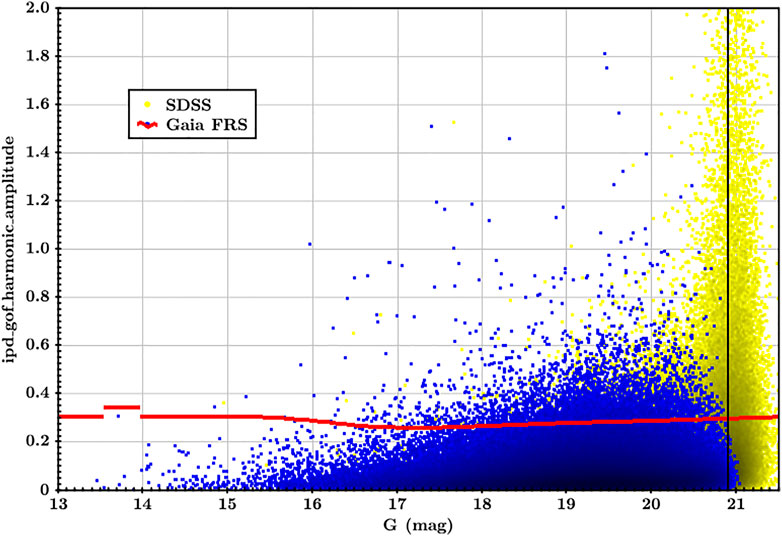
FIGURE 4. The ipd_gof_harmonic_amplitude vs. Gmag. The blue dots represent the sources from Gaia FRS, while the yellow dots are the common sources from Gaia EDR3 and SDSS DR16Q. The red curve is the 99% quantile of Gaia FRS, and the black vertical line represents G = 20.9 mag.
ipd_frac_multi_peak is another important parameter for evaluating whether the source is a binary. It provides the percent of successful-IPD (Image Parameters Determination) windows with more than one peak, and we could preliminarily judge whether a source is a visually resolved double star based on this parameter. Normally, all sources with percent greater than zero should be selected as abnormal quasar candidates, and totally, we found that there are 32,578 sources in FRS whose ipd_frac_multi_peak is greater than zero, with only 3,215 (10%) of them greater than one. A large number of sources with ipd_frac_multi_peak = 1 may increase the contamination of our final catalog, and ipd_frac_multi_peak > 1 can be used to select some extreme quasars efficiently. So we take ipd_frac_multi_peak > 1 as the criterion: in this case, 3,392 (0.7% of SDSS quasars) quasars are selected.
With the considerations above, we propose the following criteria for selecting abnormal quasars in SDSS DR16Q:
we finally obtained 44 quasars that met all of the above criteria, and these quasars are included in the type B catalog of abnormal quasars (Catalog B hereafter).
3 Result
In Table 1 and Table 2 we detail the contents of our catalogs. The sky distribution of the two catalogs is shown in Figure 5. There are 108/3093 (35.0%) 2-parameter Gaia sources in Catalog A, and for Catalog B, the rate is 26/44 (59.1%). Therefore, for the two whole catalogs, the position errors are obviously greater than those of Gaia FRS and SDSS DR16Q as expected, see Figure 6. For the 5-parameter and 6-parameter sources in Catalog A and B, the normalized proper motion and parallax distributions are shown in Figure 7. Compared to the almost zero parallax and proper motion of Gaia FRS, the sources in Catalog A and B have worse astrometric solutions. The Gaia celestial reference frame (Gaia-CRF3) is materialised by 1,614,173 quasars in GEAC (Brown et al., 2021), and we find that there are 111 common sources between GEAC and catalog A, and 16 common sources with Catalog B, which we recommend removing from GEAC. Figure 8 shows the redshift distribution of these two catalogs: we find that the distribution of Catalog A and SDSS DR16Q is almost consistent. However, the sources in Catalog B are distributed more in the low redshift part, and almost no sources in Catalog B have a redshift in the range of 0.5–0.8.
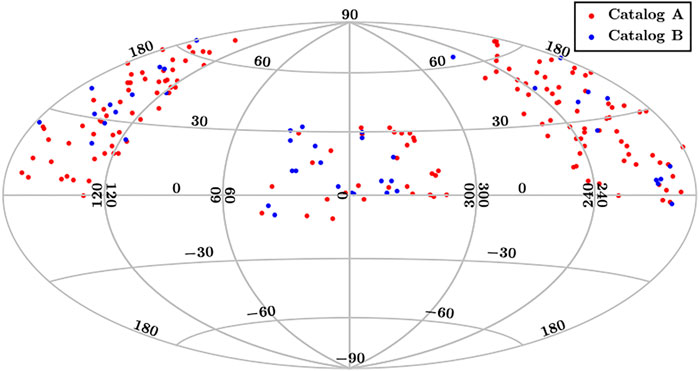
FIGURE 5. The sky distribution of the sources in Catalog A and B. The map uses the Hammer Aitoff projection in Equatorial coordinates.

FIGURE 6. The cumulative distribution histogram for σα* (A) and σδ (B) of sources in Gaia FRS, SDSS DR16Q, Catalog A and Catalog B.

FIGURE 7. The normalized proper motion (A) and parallax ϖ/σϖ (B) distributions for sources in Catalog A and Catalog B.
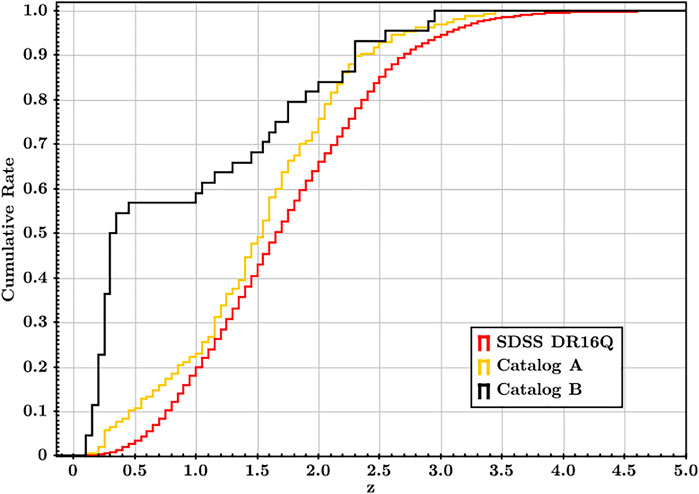
FIGURE 8. The cumulative distribution histogram for redshift of sources in SDSS DR16Q, Catalog A and Catalog B.
As we mentioned above, the spectroscopically identified SDSS DR16Q has a contamination of 0.3–1.3%, which is estimated by implementing the visual inspection of the spectra of a randomly chosen sample (Lyke et al., 2020). In Catalog A, for the 155 SDSS spectroscopically identified quasars, 43 have been visually inspected, and 36 are Quasars, while seven of them are identified as BAL Quasars. Of the remaining 112 sources with only spectral identification, 98 have been included in LQAC54 (Souchay et al., 2019), and the remaining 14 quasars are newly identified by SDSS DR16Q. In Catalog B, 10 of the 44 SDSS quasars have been visually inspected, and all of them are Quasars. For the remaining 34 sources with only spectral identification, 24 have been included in LQAC5, and the remaining 10 quasars are newly identified by SDSS DR16Q. Therefore, we believe the quasars in our catalog are reliable.
We have checked the SDSS images of the sources in Catalog A and B. Some of them show obvious characteristics of a binary system, so these quasars may be potential quasar pairs. The details of the two catalogs are given below.
3.1 Catalog A
The sources in Catalog A have more than one matched source in Gaia or SDSS within a 1″ radius. They may be quasar pairs, star-quasar pairs, active galactic nuclei with obvious jets, or lensing objects. For the two sources with three Gaia sources matched, the Simbad Astronomical database (Wenger et al., 2000) shows that there is a significant lensing effect near these two sources. Their SDSS IDs are 091127.61 + 055054.1 and 141546.24 + 112943.4, as mentioned above, they may be lensing objects, but more analysis is needed to determine that.
To eliminate the interference of foreground stars, we mark some 5-parameter and 6-parameter sources with significant parallaxes and proper motions, which means that they might be star-quasar pairs. If at least one source in a pair has |ϖ/σϖ| > 5, or
There are 64 extended sources and 91 point-like sources contained in Catalog A. Figure 9 shows several bright sources in Catalog A. For the point-like sources, most of them only have one optical center except Figure 9B, but the Gaia high-precision observation indicates that there is more than one source in 1″ radius of each SDSS position. Therefore more observations are needed for identifying if they are quasar pairs. For the extended sources, some of them exhibit obvious galaxy structures, such as Figures 9F,H, while other extended sources may be caused by bright jets. In addition, the mean redshift of the extended sources is 1.19, and the average is 1.69 for the point-like sources. Therefore, these point-like sources are very important for studying high-redshift quasar pairs.
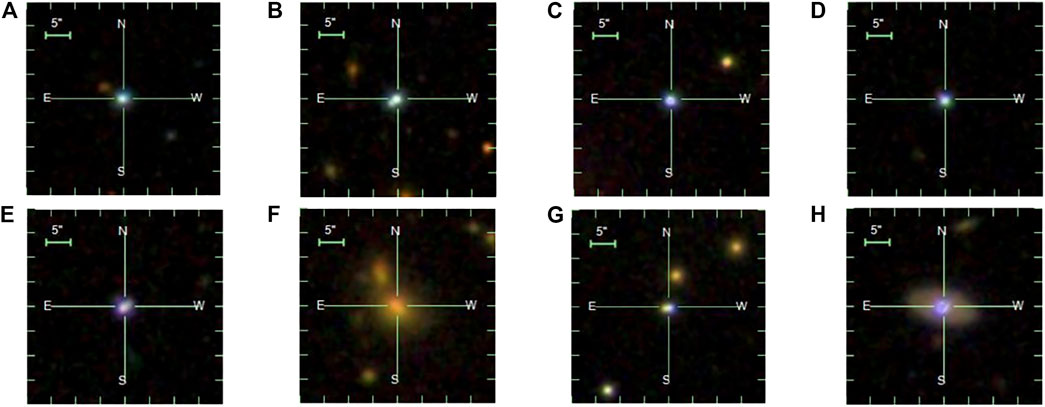
FIGURE 9. Eight SDSS images of sources in Catalog A, the top panels (A–D) are four point-like sources, while the bottom panels (E–H) are four extended sources.
3.2 Catalog B
The sources in Catalog B are abnormal quasars, whose astrometric observation parameters deviate significantly from the entire sample. In Gaia EDR3, all kinds of sources must be solitary. It means if there are multiple sources found within a 0.18″ radius, the database will only keep one source with a flag named “duplicated_source” (Lindegren et al., 2021). Although this flag does not definitely indicate that the source is a binary, it can be used as a reference to assess the reliability of the catalog. The proportion of duplicate sources in Catalog B is 11/44 (25%), while the ratios in SDSS DR16Q and Gaia FRS are 0.9 and 0.6%, respectively, which shows that our selection criteria are effective.
Figure 10, panel (A), (B), (E), (F) are four quasars with the flag “duplicated_source”, while the remaining four without this flag. Due to the low resolution of SDSS, there is no obvious difference between the images of duplicated and non-duplicated sources. Therefore, to further confirm whether these sources are quasar pairs or not, higher-resolution observations are needed, or maybe a method that combines spectral and light curves could be effective. Among the 25 extended sources, J115517.34 + 634622.0 is the only one with a redshift greater than 0.5, and its redshift is 2.9. The SDSS image of the source shown in Figure 10H also exhibits a distinct dual optical center. Consistent with Catalog A, the average redshift of the point-like sources is 1.71, and the average redshift of the extended sources except J115517.34 + 634622.0 is 0.21. The huge redshift gap between the extended sources and the point sources may be because the extended structures of the long-distance high-redshift point sources are too faint to be observed.
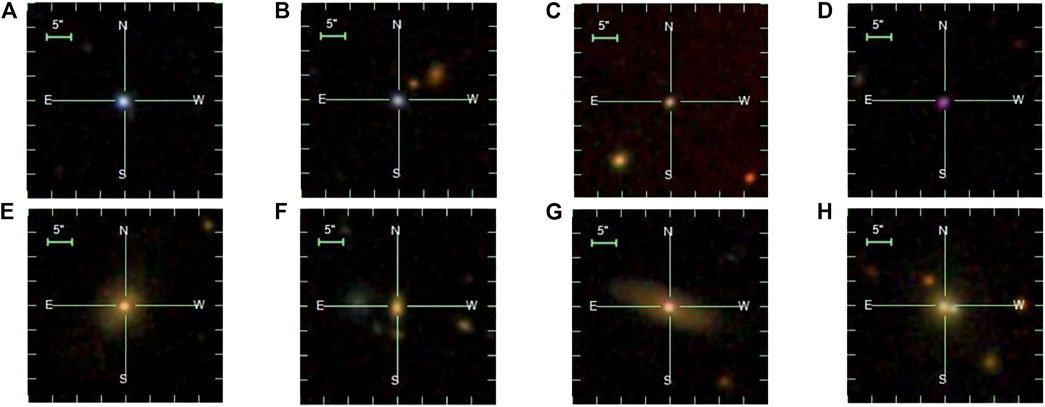
FIGURE 10. Eight SDSS images of sources in Catalog B, the top panels (A–D) are four point-like sources, while the bottom panels (E–H) are four extended sources.
4 Discussion
4.1 Extened Catalogs With Different Combination of the Criteria
As we mentioned above, there are 0.9% of SDSS DR16Q quasars with the flag “duplicated_source”. Although the proportion is very small, the number is huge. 4472 SDSS quasars with G
To select different kinds of abnormal sources, we consider three subsets of criteria in Eq. 1: (1), the sources meet the criteria (i), (ii), (iii) and (vi); (2), the sources meet the criteria (iv), (v) and (vi); (3), the sources met the criteria (iv), (v) and (vi) but not the criteria (i), (ii) and (iii). The above three samples are respectively compiled into the Extended Catalog 1, 2, 3 of Catalog B (hereafter as EB1, EB2, EB3, respectively). According to their respective selection criteria, the sources in EB1 have bad fitting results in Gaia EDR3, and the sources in EB2 may be visually resolved binaries. EB3 contains the sources which have high percents of multi-peak but low noises, which means that there is another source near the EB3 source. Table 3 shows some statistical information of the three catalogs. Consistent with Catalog A and B, the catalogs with more extended sources have lower average redshift. There are hundreds of common sources in Extended catalogs of Catalog B and GEAC. Figure 11 shows that the sources in EB2 have slightly worse position precision than SDSS DR16Q sources, and the position precision of sources in EB1 is even worse than that of EB2. The number of duplicated sources in Table 3 also shows that we only select a small part of abnormal quasars.

FIGURE 11. The cumulative distribution histogram for σα* (A) and σδ (B) of sources in Gaia FRS, SDSS DR16Q, EB1, EB2 and EB3.
In addition to the above criteria, the renormalized unit weight error (ruwe) may also be a criterion that can be used to select binaries. In Gaia Data release 2 (DR2), ruwe
Apart from the SDSS DR16Q, there are many other reliable quasar catalogs such as the Large Bright Quasar Survey (Hewett et al., 1995), the INT Wide Angle Survey (Sharp et al., 2001), and the quasars from Large Sky Area Multi-Object Fiber Spectroscopic Telescope (LAMOST) (Zhao et al., 2012). With our method of selecting abnormal astrometric quasars, a large number of quasar pair candidates will be selected.
4.2 Identification of Quasar Pairs and Lensed Quasars
In Section 2, we have described the selection criteria and hence obtained two samples of abnormal quasars denoted as Catalog A and B. It is also interesting to explore the nature of these sources, whether they are quasar pairs, lensing images or containing jet-like structures. With the high-resolution observations from Hubble Space Telescope (HST), we could firstly resolve the general structures of these abnormal quasars, and further analysis of the corresponding spectra and light curves will be needed for a detailed classification.
There are about a dozen sources in Catalog A and Catalog B that have been identified as lensed quasars in the literatures. For example, Figure 13 shows the SDSS image (left side) and the HST optical image (right side) of the lensed quasar SDSS 111816.94 + 074558.2 as identified in catalog A, already reported in (Weymann et al., 1980; Impey et al., 1998). We could see the advantage of the higher resolution of HST compared with SDSS when resolving the structure of those abnormal quasars. We also note that two similar pioneer works by Shen et al. (2021) and Chen et al. (2022) have reported 2 and 43 AGN pair candidates, respectively, using the methods of varstrometry (i.e., excess astrometric noise). Among the sources we selected in this paper, 8 sources in Catalog A, 2 sources in Catalog B and 5 sources in EB1 have been reported as AGN pair candidates in their papers. However, both the target sample and the selection criteria are a little bit different. We will compare our results with them in future work.
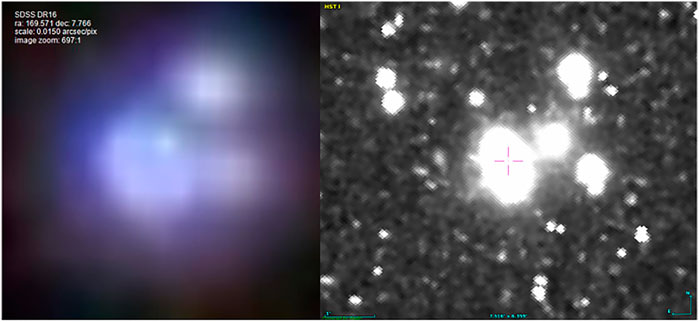
FIGURE 13. SDSS (left side) and HST optical image (right side) of the lensed quasar SDSS 111816.94 + 074558.2, respectively. For the SDSS image, the resolution is 0.015 arcsec per pixel with 512 pixel in total. While for the HST image, the FOV is 7.516” × 6.359″ and the scale 1″ is labelled as the light blue line segment in the right panel.
5 Conclusion
By cross-matching with other quasar catalogs, Gaia EDR3 provides high-precision astrometric data for a large number of quasars, and a list of 1,614,173 quasar candidates are obtained, which could be used to establish the celestial reference frame in the optical band. However, during the selection process, many spectroscopically identified quasars showed abnormal astrometric characteristics, such as significant parallaxes and large proper motions. These quasars may come with astrometric jitter detectable with Gaia data. Therefore, with several Gaia parameters describing the goodness of data fitting, quasars with abnormal astrometric characteristics could be selected. The selected quasars can form a group of quasar pair candidates.
We propose a series of criteria for selecting abnormal quasars based on Gaia astrometric data. Since Gaia EDR3 contains 344 million 2-parameter sources, this means that these sources have only positional parameters. Our criteria do not rely on the complete data of parallax and proper motion, but depend on the goodness of fit to the observed data. With these criteria, two catalogs are obtained. Catalog A contains 155 SDSS quasars with more than one Gaia matched within a 1″ radius. Catalog B contains 44 SDSS quasars whose Gaia observations are significantly different from the best-fitting standard astrometric model. The percentages of extended sources in Catalogs A and B are 41.3 and 56.8%, respectively. And in both catalogs, the mean redshift of the extended sources is significantly smaller than that of the point sources.
Although some of the SDSS images show obvious double star features, there are still many sources in our catalogs for which it is not possible to determine whether they are quasar pairs at the resolution of SDSS. Therefore, more high-resolution observations are needed to determine the fraction of quasar pairs of the catalogs in the future. In addition to SDSS DR16Q, many other quasar catalogs need to be further checked, so more efforts are needed to improve the selection criteria.
There are 127 common sources between the GEAC quasars and our Catalog A and B, which should be excluded from GEAC for the purpose of establishing a reference frame. Besides, hundreds of common sources between Extended Catalogs of Catalog B and GEAC also show large position errors. The aspects of morphology and astrometric variability were crucial for selecting the quasars to form the reference frame (Ma et al., 2009). A perturbation in the disk of the host galaxy can cause a significant offset to the photocenter in the Gaia observations (Popović et al., 2012). Andrei et al. (2012) used the morphological indexes in the Gaia Initial QSO Catalog to indicate such influences. The host detection and characterization for about 1 million quasars will be released in the future release of Gaia DR3. It might be interesting in the future to see if there is any correlation between the morphological parameters and the astrometric parameters mentioned in the current paper.
Data Availability Statement
The original contributions presented in the study are included in the article/Supplementary Material, further inquiries can be directed to the corresponding author.
Author Contributions
S-LL is responsible for supervising the finding and selection of abnormal quasars from the Gaia data. Q-QW selected the Gaia EDR3 and SDSS data with meticulous efforts and wrote the manuscript with help mainly from S-LL and XJ. Besides, Z-XQ, Z-YZ, Y-KZ, and TA contributed to the physical interpretation and discussion. XJ and R-QL contributed to collecting the SDSS data.
Funding
This work has been supported by the Youth Innovation Promotion Association CAS, the grants from the Natural Science Foundation of Shanghai through grant 21ZR1474100, the National Natural Science Foundation of China (NSFC) through grants 12173069, 11703065, 11773051, 12022303 and the National Key R&D Programme of China through grant 2018YFA0404603. We acknowledge the CAS Pioneer Hundred Talents Program and the science research grants from the China Manned Space Project with NO. CMS-CSST-2021-A12 and NO. CMS-CSST-2021-B10.
Conflict of Interest
The authors declare that the research was conducted in the absence of any commercial or financial relationships that could be construed as a potential conflict of interest.
Publisher’s Note
All claims expressed in this article are solely those of the authors and do not necessarily represent those of their affiliated organizations, or those of the publisher, the editors and the reviewers. Any product that may be evaluated in this article, or claim that may be made by its manufacturer, is not guaranteed or endorsed by the publisher.
Acknowledgments
This work has made use of data from the European Space Agency (ESA) mission Gaia (https://www.cosmos.esa.int/gaia), processed by the Gaia Data Processing and Analysis Consortium (DPAC, https://www.cosmos.esa.int/web/gaia/dpac/consortium). Funding for the DPAC has been provided by national institutions, in particular the institutions participating in the Gaia Multilateral Agreement. We are very grateful for the data provided by SDSS. Funding for the Sloan Digital Sky Survey IV has been provided by the Alfred P. Sloan Foundation, the U.S. Department of Energy Office of Science, and the Participating Institutions. SDSS-IV acknowledges support and resources from the Center for High Performance Computing at the University of Utah. The SDSS website is www.sdss.org. This research has also made use of the SIMBAD database and the data of Hubble Space Telescope. We are also very grateful to the developers of the TOPCAT (Taylor, 2005) software.
Supplementary Material
The Supplementary Material for this article can be found online at: https://www.frontiersin.org/articles/10.3389/fspas.2022.822768/full#supplementary-material
Supplementary Data Sheets 1-5 | The Supplemental Data of this paper contains Catalog A, Catalog B and three extended catalogs of Catalog B. The descriptions of Catalogs A and B can be found in Table 1 and Table 2, and for the three extended catalogs, we provide the Gaia source_id and the corresponding SDSS_id of these sources. Data Tables 1-5 correspond to Catalog A, Catalog B, EB1, EB2, and EB3, respectively.
Footnotes
1In Gaia EDR3, there are three types of sources according to the astrometric solutions, the position (right ascension and declination), parallax and two components of proper motion are available for 5-parameter sources, the astrometrically estimated effective wavenumber together with the above five parameters are available for 6-parameter sources, and for 2-parameter sources, only positional data are provided (Lindegren et al., 2021).
2The criterion select the bright sources (
3Due to the multiple matches, we obtained 151*2 + 2*3 + 1 = 309 Gaia sources
4The quasars in LQAC5 are compiled from SDSS DR14Q and other quasar catalogs, the newly identified quasars in SDSS DR16Q are not included
References
Andrei, A. H., Souchay, J., Martins, R. V., Anton, S., Taris, F., Bouquillon, S., et al. (2012). Morphology of Qsos-The Gridpoints of the Gaia Celestial Reference Frame. IAU Jt. Discussion 31, 14–23.
Begelman, M. C., Blandford, R. D., and Rees, M. J. (1980). Massive Black Hole Binaries in Active Galactic Nuclei. Nature 287, 307–309. doi:10.1038/287307a0
Blanton, M. R., Bershady, M. A., Abolfathi, B., Albareti, F. D., Prieto, C. A., Almeida, A., et al. (2017). Sloan Digital Sky Survey Iv: Mapping the Milky Way, Nearby Galaxies, and the Distant Universe. Astron. J. 154, 28. doi:10.3847/1538-3881/aa7567
Brown, A. G., Vallenari, A., Prusti, T., De Bruijne, J., Babusiaux, C., Biermann, M., et al. (2021). Gaia Early Data Release 3-summary of the Contents and Survey Properties. Astron. Astrophys. 649, A1. doi:10.1051/0004-6361/202039657e
Charlot, P., Jacobs, C. S., Gordon, D., Lambert, S., de Witt, A., Böhm, J., et al. (2020). The Third Realization of the International Celestial Reference Frame by Very Long Baseline Interferometry. Astron. Astrophysics 644, A159. doi:10.1051/0004-6361/202038368
Chen, Y.-C., Hwang, H.-C., Shen, Y., Liu, X., Zakamska, N. L., Yang, Q., et al. (2022). Varstrometry for Off-Nucleus and Dual Sub-kpc Agn (Vodka): Hubble Space Telescope Discovers Double Quasars. Astrophys. J. 925 (2), 162. doi:10.3847/1538-4357/ac401b
Croom, S. M., Smith, R., Boyle, B., Shanks, T., Miller, L., Outram, P., et al. (2004). The 2df Qso Redshift Survey–Xii. The Spectroscopic Catalogue and Luminosity Function. Monthly Notices R. Astron. Soc. 349, 1397–1418. doi:10.1111/j.1365-2966.2004.07619.x
Flesch, E. W. (2021). The Million Quasars (Milliquas) V7. 2 Catalogue, Now with Vlass Associations. The Inclusion of Sdss-Dr16q Quasars Is Detailed. arXiv preprint arXiv:2105.12985
Guo, S., Qi, Z., Liao, S., Cao, Z., Lattanzi, M. G., Bucciarelli, B., et al. (2018). Identifying Quasars with Astrometric and Mid-infrared Methods from Apop and Allwise. Astron. Astrophys. 618, A144. doi:10.1051/0004-6361/201833135
Hewett, P. C., Foltz, C. B., and Chaffee, F. H. (1995). The Large Bright Quasar Survey. 6: Quasar Catalog and Survey Parameters. Astron. J. 109, 1498–1521. doi:10.1086/117380
Impey, C., Falco, E., Kochanek, C., Lehár, J., McLeod, B., Rix, H.-W., et al. (1998). An Infrared Einstein Ring in the Gravitational Lens Pg 1115+ 080. Astrophys. J. 509, 551. doi:10.1086/306521
Jönsson, H., Holtzman, J. A., Prieto, C. A., Cunha, K., García-Hernández, D., Hasselquist, S., et al. (2020). Apogee Data and Spectral Analysis from Sdss Data Release 16: Seven Years of Observations Including First Results from Apogee-South. Astron. J. 160, 120. doi:10.3847/1538-3881/aba592
Klioner, S., Mignard, F., Lindegren, L., Bastian, U., McMillan, P., Hernández, J., et al. (2021). Gaia Early Data Release 3-acceleration of the Solar System from Gaia Astrometry. Astron. Astrophys. 649, A9.
Liao, S.-L., Qi, Z.-X., Guo, S.-F., and Cao, Z.-H. (2019). A Compilation of Known Qsos for the Gaia mission. Res. Astron. Astrophys. 19, 029. doi:10.1088/1674-4527/19/2/29
Liao, S., Qi, Z., Cao, Z., and Tang, Z. (2021a). Probing the Properties of Gaia-Crf2 Quasars at the Faintest Magnitudes. Publ. Astron. Soc. Pac. 133, 024501. doi:10.1088/1538-3873/abd4bd
Liao, S., Wu, Q., Qi, Z., Tang, Z., Luo, H., and Cao, Z. (2021b). Probing the Astrometric Properties of Gaia Edr3 Quasars at the Faintest Magnitudes. Publ. Astron. Soc. Pac. 133, 094501. doi:10.1088/1538-3873/ac1eeb
Lindegren, L., Lammers, U., Hobbs, D., O’Mullane, W., Bastian, U., and Hernández, J. (2012). The Astrometric Core Solution for the Gaia mission-overview of Models, Algorithms, and Software Implementation. Astron. Astrophys. 538, A78. doi:10.1051/0004-6361/201117905
Lindegren, L., Hernández, J., Bombrun, A., Klioner, S., Bastian, U., Ramos-Lerate, M., et al. (2018). Gaia Data Release 2-the Astrometric Solution. Astron. Astrophys. 616, A2.
Lindegren, L., Klioner, S., Hernández, J., Bombrun, A., Ramos-Lerate, M., Steidelmüller, H., et al. (2021). Gaia Early Data Release 3-the Astrometric Solution. Astron. Astrophys. 649, A2. doi:10.1051/0004-6361/202039709
Luo, A.-L., Zhang, H.-T., Zhao, Y.-H., Zhao, G., Cui, X.-Q., Li, G.-P., et al. (2012). Data Release of the Lamost Pilot Survey. Res. Astron. Astrophys. 12, 1243.
Lyke, B. W., Higley, A. N., McLane, J., Schurhammer, D. P., Myers, A. D., Ross, A. J., et al. (2020). The sloan Digital Sky Survey Quasar Catalog: Sixteenth Data Release. Astrophys. J. Suppl. Ser. 250, 8. doi:10.3847/1538-4365/aba623
Ma, C., Arias, E., Bianco, G., Boboltz, D., Bolotin, S., Charlot, P., et al. (2009). The Second Realization of the International Celestial Reference Frame by Very Long Baseline Interferometry. IERS Tech. note 35, 29–36.
Ma, C. (1997). Realization of the International Celestial Reference Frame from Vlbi Astrometry. Am. Astron. Soc. Meet. Abstr. 191, 16–13.
Mignard, F., Klioner, S., Lindegren, L., Hernandez, J., Bastian, U., Bombrun, A., et al. (2018). Gaia Data Release 2-the Celestial Reference Frame (Gaia-crf2). Astron. Astrophys. 616, A14. doi:10.1051/0004-6361/201832916
Pâris, I., Petitjean, P., Aubourg, É., Myers, A. D., Streblyanska, A., Lyke, B. W., et al. (2018). The sloan Digital Sky Survey Quasar Catalog: Fourteenth Data Release. Astron. Astrophys. 613, A51. doi:10.1051/0004-6361/201732445
Popović, L., Jovanović, P., Stalevski, M., Anton, S., Andrei, A. H., Kovačević, J., et al. (2012). Photocentric Variability of Quasars Caused by Variations in Their Inner Structure: Consequences for Gaia Measurements. Astron. Astrophys. 538, A107. doi:10.1051/0004-6361/201117245
Prusti, T., De Bruijne, J., Brown, A. G., Vallenari, A., Babusiaux, C., Bailer-Jones, C., et al. (2016). The Gaia mission. Astron. Astrophys. 595, A1. doi:10.1051/0004-6361/201629272
Schmidt, M. (1963). 3 C 273: a Star-Like Object with Large Red-Shift. Nature 197, 1040. doi:10.1038/1971040a0
Secrest, N., Dudik, R., Dorland, B., Zacharias, N., Makarov, V., Fey, A., et al. (2015). Identification of 1.4 Million Active Galactic Nuclei in the Mid-infrared Using wise Data. Astrophys. J. Suppl. Ser. 221, 12. doi:10.1088/0067-0049/221/1/12
Sharp, R., McMahon, R., Irwin, M., and Hodgkin, S. (2001). First Results from the Isaac newton Telescope Wide Angle Survey: the Z> 5 Quasar Survey. Monthly Notices R. Astron. Soc. 326, L45–L49. doi:10.1111/j.1365-2966.2001.04845.x
Shen, Y., Hwang, H.-C., Zakamska, N., and Liu, X. (2019). Varstrometry for Off-Nucleus and Dual Sub-kpc Agn (Vodka): How Well Centered Are Low-Z Agn? Astrophysical J. Lett. 885, L4. doi:10.3847/2041-8213/ab4b54
Shen, Y., Chen, Y.-C., Hwang, H.-C., Liu, X., Zakamska, N., Oguri, M., et al. (2021). A Hidden Population of High-Redshift Double Quasars Unveiled by Astrometry. Nat. Astron. 5, 569–574. doi:10.1038/s41550-021-01323-1
Souchay, J., Gattano, C., Andrei, A., Souami, D., Coelho, B., Barache, C., et al. (2019). Lqac-5: The Fifth Release of the Large Quasar Astrometric Catalogue-A Compilation of 592 809 Objects with 398 697 Gaia Counterparts. Astron. Astrophys. 624, A145. doi:10.1051/0004-6361/201834955
Taylor, M. B. (2005). Topcat & Stil: Starlink Table/votable Processing Software. Astron. Data Anal. Softw. Syst. XIV 347, 29.
Véron-Cetty, M.-P., and Véron, P. (2010). A Catalogue of Quasars and Active Nuclei. Astron. Astrophys. 518, A10. doi:10.1051/0004-6361/201014188
Wenger, M., Ochsenbein, F., Egret, D., Dubois, P., Bonnarel, F., Borde, S., et al. (2000). The Simbad Astronomical Database-The Cds Reference Database for Astronomical Objects. Astron. Astrophys. Suppl. Ser. 143, 9–22. doi:10.1051/aas:2000332
Weymann, R. J., Latham, D., Angel, J. R. P., Green, R. F., Liebert, J. W., Turnshek, D. A., et al. (1980). The Triple Qso Pg1115+ 08: Another Probable Gravitational Lens. Nature 285, 641–643. doi:10.1038/285641a0
Wu, Q., Liao, S., Qi, Z., Luo, H., Tang, Z., and Cao, Z. (2021). A Catalog of Quasar Candidates Identified by Astrometric and Mid-infrared Methods in Gaia Edr3. arXiv preprint arXiv:2111.02131
Keywords: astrometry, catalogs, quasars, quasar pairs, reference frame
Citation: Wu Q-Q, Liao S-L, Ji X, Qi Z-X, Zheng Z-Y, Lin R-Q, Zhang Y-K and An T (2022) SQUAB—I: The First Release of Strange QUasar Candidates With ABnormal Astrometric Characteristics From Gaia EDR3 and SDSS. Front. Astron. Space Sci. 9:822768. doi: 10.3389/fspas.2022.822768
Received: 26 November 2021; Accepted: 28 January 2022;
Published: 07 March 2022.
Edited by:
Beatrice Bucciarelli, National Institute of Astrophysics (INAF), ItalyReviewed by:
Jia-Cheng Liu, Nanjing University, ChinaNorbert Zacharias, United States Naval Observatory (USNO), United States
Copyright © 2022 Wu, Liao, Ji, Qi, Zheng, Lin, Zhang and An. This is an open-access article distributed under the terms of the Creative Commons Attribution License (CC BY). The use, distribution or reproduction in other forums is permitted, provided the original author(s) and the copyright owner(s) are credited and that the original publication in this journal is cited, in accordance with accepted academic practice. No use, distribution or reproduction is permitted which does not comply with these terms.
*Correspondence: Shi-Long Liao, c2hpbG9uZ2xpYW9Ac2hhby5hYy5jbg==
 Qi-Qi Wu
Qi-Qi Wu Shi-Long Liao
Shi-Long Liao Xiang Ji
Xiang Ji Zhao-Xiang Qi
Zhao-Xiang Qi Zhen-Ya Zheng
Zhen-Ya Zheng Ru-Qiu Lin
Ru-Qiu Lin Ying-Kang Zhang
Ying-Kang Zhang Tao An
Tao An
